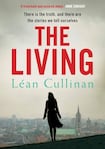
Coincidence, said Albert Einstein, is God's way of remaining anonymous. Should he choose to settle down on the celestial throne, however, to read The Living, his cover might quickly be blown as the sound of a deified baritone roaring "Oh, come on!" at the number of implausibilities littered across the pages blasts through the clouds. God is tolerant, we're told, but everyone has a breaking point.
Of the glut of debut Irish novels of recent years, surprisingly few have been written by women. The audacity of this novel's title, a direct counterpart to Joyce's most famous story, offers hope that Léan Cullinan will bring some gender balance to the new company of writers, but sadly The Living is built on such a shaky premise and populated by so many dim-witted characters that these aspirations are quickly dashed.
The novel is narrated by Cate Houlihan, a young graduate working for a small Irish publisher while singing in a choir in her free time. Her disappointment that she has not yet found her true calling is well drawn, and scenes of family dinners where she keeps one eye on the clock for a quick exit are confidently handled.
Cate herself seems curiously vacant, lacking in ambition or drive, and springs to life only when a new tenor, Matthew, joins the chorus. Of course, we realise: she just needs a man. Take that, feminism.
It’s clear from early on that Matthew, introverted and secretive, is not to be trusted, but Cate falls for him quickly, perhaps because he too seems untroubled by a personality and has the conversation skills of a corpse. He’s handsome, though, and apparently that’s all that matters. But for Cate to ignore the warning signs that flash like a neon billboard makes her seem at best naïve and at worst downright stupid.
“Why did I have to be such an ignoramus?” she asks in a rare moment of personal clarity. You don’t have to be, is the answer. It’s just the way you’re written.
An intriguing backstory involves generational involvement in the IRA, and Cate becomes an unwitting go-between in the passing of information about a republican’s controversial memoirs. As not just one but two characters conveniently “distrust” email, she collects manuscripts, holds secret meetings in coffee shops and hides memory sticks in her bra, never thinking any of this strange.
Credibility is stretched to breaking point when details of an innocuous train journey taken by a nameless civil servant during the Harold Wilson era, a minor point related to Matthew's PhD, happen to show up in the manuscript Cate is working on and this becomes a point of contention between them.
The novel perks up a little when Matthew’s romantic ardour begins to lessen, leading her to compromise her professional ethics in order to maintain his interest. But with so little spark between the two – he seems entirely uninterested, she’s needy and a bit of a stalker – that it’s difficult to care. Neither has an inner life, and Cate seems more interested in telling the world about her relationship than simply experiencing it. If her name began with a K instead of a C she would not feel out of place in the Kardashian family.
It’s not unusual for a debut novelist to create eccentricities for their characters, but a wise editor would have expunged some of the more annoying. Matthew signs all his text messages with the number 990 and offers a convoluted explanation relating to Roman numerals, kisses and his own initial. The joke, such as it is, wears thin fast. The choir’s token homosexual is, of course, camp, flirtatious and bursting with innuendo, because it’s written into the Constitution that this is the only way that gay characters can ever be presented in Irish fiction. Worst of all is Cate’s Uncle Fintan, who omits the final word from his sentences, an affectation so ridiculous that news of his eventual incapacity provokes relief. At least we won’t have to figure out what he’s trying to say any more.
The real problem with The Living is that it can't decide what type of novel it wants to be. Essentially it's a thriller – a sly nod towards John le Carré is easily the book's most successful witticism – but Cate appears to have wandered into the story directly from the pages of the most hackneyed piece of chick lit, as if there were an error at the printers and the poor thing got lost looking for her own novel.
And although it has pretensions towards literary fiction, the cliches, lack of character insight and tedious repetitions put an end to that. Cate can’t walk past a tree without the branches “whispering” at her, and when she remarks that she likes her job it’s encouraging to know, two pages later, that she “continues” to like her job. That’s clear, at least. She likes her job.
“There is the truth,” the novel’s tag line declares on the cover, “and there are the stories we tell ourselves.” Sadly, the truth is that this debut, which bears the intriguing premise of examining the effect of republican activities on the post-peace generation, fails to excite the imagination and ultimately feels sloppy and ill conceived. As Uncle Fintan might put it, it’s just no.















